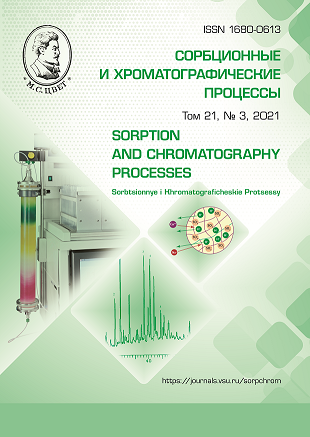Equilibrium and kinetic characteristics of phenol sorption by a nonionic sorbent FPX66
Abstract
Hydroxybenzene, or phenol, is a very dangerous ecotoxicant that can have quite a detrimental effect on human life and health. Based on this, there is a need to elaborate effective technologies that can purify surface and wastewater from this organic pollutant. One of the possible technologies for the extraction of phenol from its aqueous solutions may be the sorption of hydroxybenzene by a macroreticular nonfunctionalized resin FPX66. In this paper, the equilibrium and kinetic characteristics of the phenol extraction process by the sorbent under study are determined. The isotherm of phenol sorption on FPX66, obtained by the method of variable concentrations, is described by the Freundlich type equation and has a high correlation coefficient in the following linear coordinates. The obtained data allow us to conclude that the surface of the studied nonionic sorbent is not homogeneous, the sorption of phenol occurs unevenly.
On the basis of the kinetic curves of the phenol sorption obtained under static conditions, the time to reach equilibrium in the system at a concentration of the initial solution of 6 mmol/dm3 and temperatures of 298 and 323±2K is determined. It is noted that with increasing temperature, the total capacity of the sorbent for phenol decreases, which is due to damage to the active binding centers of the sorbent when the system is heated. However, with an increase in temperature, the equilibrium in the system is reached faster. The rate of the sorption process can also be increased by increasing the stirring rate of the external phenol solution. The study was carried out at 150, 200 and 250 rpm of a thermostatically controlled shaker.
The estimation of the limiting stage of the sorption process is carried out using a formal approach based on the application of the Boyd-Adamson equation for external and internal diffusion. The results show that the main influence on the extraction of hydroxybenzene by the nonionic sorbent FPX66 is exerted by the stage of external diffusion of the sorbate to the surface of the sorbent granules.
Downloads
References
Rudakov O.B., Horohordina E.A., Preobrazhensky M.A., Rudakova L.V., Journal of Physical Chemistry, 2016, Vol. 90, No 8, pp. 1257-1260.
Halikov I.S., Bulletin of Scientific Con-ferences, 2016, Vol. 11, No 7-3, pp. 129-130.
Smirnova A.A., Grigorieva L.S., Os-trouhov N.N., Solid Fuel Chemistry, 2016, No, 6, pp. 40-44.
Terreros J., Zaragoza P., Vazquez E., Muro C., Afinidad, 2018, Vol. 75, No 584, pp. 272-278.
Kiai H., Garcia-Payo M.C., Hafidi A., Khayet M., Chemical Engineering and Pro-cessing: Process Intensification, 2014, Vol. 86, pp. 153-161. DOI: 10.1016/j.cep.2014.09.007
Mnif A., Tabassi D., Ben Sik Ali M., Hamrouni B., Environmental Progress and Sustainable Energy, 2015, Vol. 4, No 3, pp. 982-989. DOI: 10.1002/ep.12078
Caetano M., Valderrama C., Farran A., Cortina J.L., Journal of Colloid and Inter-face Science, 2009, No 338, pp. 402-409. DOI: 10.1016/j.jcis.2009.06.062
Ochando-Pulido J.M., Vellido-Perez J.A., Gonzalez-Hernandez R., Martinez-Ferez A., Separation and Purification Tech-nology, 2020, Vol. 249, pp. 1-12. DOI: 10.1016/j.seppur.2020.117084
Kaleta J., Papciak D., Puszkarewicz A., Journal of Ecological Engineering, 2018, Vol. 19, pp. 136-142. DOI: 10.12911/22998993/89662
Korosteleva A.V., Tyurdeneva S.V., XXI century: the results of the past and the problems of the present plus, 2013, Vol. 2, No 9, pp. 164-169.
Telyasheva L.R., XXIV Tupolev Readings (School of young scientists), Ka-zan, 2019, pp. 468-471.
Selemenev V.F., Slavinskaya G.V., Khokhlov V.Yu. et al. Praktikum po ionno-mu obmenu, Voronezh, Voronezh State Uni-versity Press, 2004, 160 p.
Mojoudi N., Mirghaffari N., So-leimani M., Shariatmadari H., et al., Scientific Reports, 2019, No 9, pp. 1-12. DOI: 10.1038/s41598-019-55794-4
Bingxin X., Jihong Q., Shu W., Xin L. et al., International Journal of Environ-mental Research and Public Health, 2020, No 17, pp. 1-13. DOI: 10.3390/ijerph17030789







